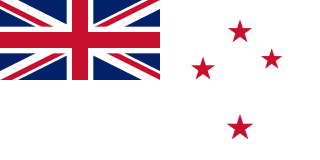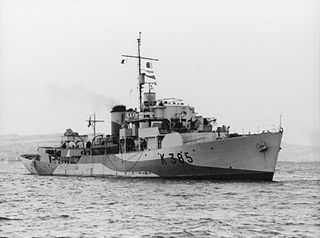Related Research Articles

The Royal New Zealand Navy is the maritime arm of the New Zealand Defence Force. The fleet currently consists of nine ships.

The British Mediterranean Fleet, also known as the Mediterranean Station, was a formation of the Royal Navy. The Fleet was one of the most prestigious commands in the navy for the majority of its history, defending the vital sea link between the United Kingdom and the majority of the British Empire in the Eastern Hemisphere. The first Commander-in-Chief for the Mediterranean Fleet was the appointment of General at Sea Robert Blake in September 1654. The Fleet was in existence until 1967.

HMS Royalist was an improved Dido-class light cruiser – one of five Bellona-class cruisers with greatly improved main armament giving more capability against sea and air targets. Light anti-aircraft armament and fire control was also improved. Royalist was further modified after completion with extra facilities and crew for directing carrier aircraft operations.

The history of the Royal New Zealand Navy leads back to early New Zealand-based gunboats used in controlling the British interests in the new colony, as well as to the strong linkages to the British Navy itself.

HMNZS Otago (F111) was a Rothesay-class frigate acquired from the United Kingdom by the Royal New Zealand Navy (RNZN) before completion.
HMNZS Waikato (F55) was a Leander Batch 2TA frigate of the Royal New Zealand Navy (RNZN). She was one of two Leanders built for the RNZN, the other being the Batch 3 HMNZS Canterbury. These two New Zealand ships relieved British ships of the Armilla patrol during the Falklands conflict, freeing British ships for deployment.

HMNZS Otago (P148) is a Protector-class offshore patrol vessel in service with the Royal New Zealand Navy. The development of the OPV design based on an Irish Naval Service OPV class was very contentious with the RNZN arguing for the need for a limited combat suite for effective training and patrol work with a 57 mm-76 mm light frigate gun and associated fire control and radar and electronic warfare systems at least compatible with current 2nd light RN OPVs while the government and Cabinet preference was to use the space and extra finance available to incorporate ice strengthening and provision of extra coastal patrol vessels. The RNZN view was that adding ice strengthening was unnecessary for Southern Ocean patrol as distinct from operation in the Ross sea and the extra weight and complexity would stress and shorten the life of the hulls from 25 to 15 years She was launched in 2006 but suffered from problems during construction and was not commissioned until 2010, two years later than planned. Soon after commissioning Otago encountered problems with both her engines which delayed her arrival at her home port of Port Chalmers. She has served on several lengthy patrols of the Antarctic, though she lacks the capability to operate in heavier levels of ice-coverage which has led to the cancellation of at least one planned operation.
Ian Leslie Stuart Blenheim Bradley was a regional councillor in Auckland, New Zealand and a former Commander and Temporary Captain in the Royal New Zealand Navy. He was the father of television presenter Sarah Bradley.

HMNZS Rotoiti (F625) was a Loch-class frigate of the Royal New Zealand Navy (RNZN), which had formerly served in the British Royal Navy as HMS Loch Katrine at the end of World War II.

HMNZS Taupo, originally HMS Loch Shin, was a Loch-class frigate which served in the Royal Navy during the Second World War, and then in the Royal New Zealand Navy (RNZN) from 1948 to 1961. She was scrapped in 1962.

HMNZS Hawea (F422), formerly HMS Loch Eck (K422), was one of six Loch-class frigates that served in both the Royal Navy (RN) and the Royal New Zealand Navy (RNZN). The ship was laid down by Smiths Dock on 25 October 1943, launched on 25 April 1943 and commissioned into the Royal Navy as HMS Loch Eck on 7 November 1944.

HMNZS Arabis was a modified Flower-class corvette of the Royal New Zealand Navy (RNZN). Built for the British Royal Navy as HMS Arabis, she was transferred to the RNZN on completion. She was commissioned in 1944 and decommissioned in 1948.

HMNZS Canterbury (F421) was one of two broad beam Leander-class frigates operated by the Royal New Zealand Navy (RNZN) from 1971 to 2005. She was built in Scotland and launched in 1970. Commissioned in 1971, Canterbury saw operational service in much of Australasia and other regions like the Persian Gulf. She undertook operations such as supporting UN sanctions against Iraq and peace-keeping in East Timor. With her sister ship HMNZS Waikato she relieved the Royal Navy frigate HMS Amazon in the Indian Ocean during the Falklands War. Early in HMNZS Canterbury's career, in 1973, she relieved the frigate HMNZS Otago, as part of a unique, Anzac, naval operation or exercise at Moruroa during anti-nuclear protests, supported by a large RAN tanker, providing fuel and a large platform for Australian media. This was due to F 421 being a more modern RNZN frigate, with then current Rn surveillance radar and ESM and a more effectively insulated frigate from nuclear fallout, with the Improved Broad Beam Leander steam plant, for example, being remote controlled and capable of unmanned operation and therefore the ship provided a more effective sealed citadel for operations in areas of nuclear explosions.

The New Zealand Division of the Royal Navy also known as the New Zealand Station was formed in 1921 and remained in existence until 1941. It was the precursor to the Royal New Zealand Navy. Originally, the Royal Navy was solely responsible for the naval security of New Zealand. The passing of the Naval Defence Act 1913 created the New Zealand Naval Forces as a separate division within the Royal Navy.
The Royal New Zealand Naval Volunteer Reserve (RNZNVR) is the volunteer reserve force of the Royal New Zealand Navy (RNZN).
Commodore George Raymond Davis-Goff was a senior officer in the Royal New Zealand Navy (RNZN).

The Torpedo Bay Navy Museum is the official museum of the Royal New Zealand Navy. It opened in 2010, to replace an earlier naval museum. The museum is in Devonport, Auckland.

Chief of Navy (CN) commands the Royal New Zealand Navy (RNZN) and is responsible to the Chief of Defence Force (CDF) for raising, training and sustaining those forces necessary to meet agreed government outputs. The CN acts as principal advisor to the CDF on Navy matters, and is the most senior appointment in the RNZN. The rank associated with the position is rear admiral, and CNs are generally appointed on a three-year term.
Ian Scott Monro was a New Zealand naval officer. He served in the Royal New Zealand Navy from 1945 to 1977, and commanded HMNZS Lachlan for four years.
References
- ↑ J O'C Ross, 'The White Ensign in New Zealand,' AH & AW Reed, 1967, p. 115
- ↑ , accessed July 2020.
- ↑ "McKenzie, Rear Admiral John". National Museum of the Royal New Zealand Navy. Archived from the original on 17 September 2016. Retrieved 10 August 2016.
- ↑ CO HMNZS Santon in Singapore (A Kiwi on Our Funnel, 95); ComAuck (Air New Zealand Almanac 1982).
- ↑ "Jack Passings – June 2015 – RNZN Communicators Association".
- ↑ East – New Chief Of Naval Staff Announced Archived 14 October 2008 at the Wayback Machine . Executive.govt.nz. Retrieved on 22 November 2011.
- ↑ http://www.dreadnoughtproject.org/tfs/index.php/Auckland - listing of postholders
- ↑ NLJan33, p. 300
- ↑ Navy List Oct35, p. 300
- ↑ NLJul37, p. 300
- http://www.dreadnoughtproject.org/tfs/index.php/Auckland - listing of postholders